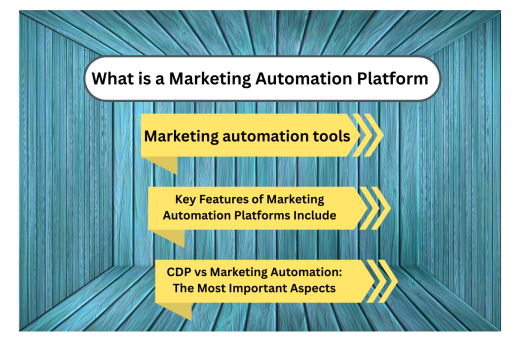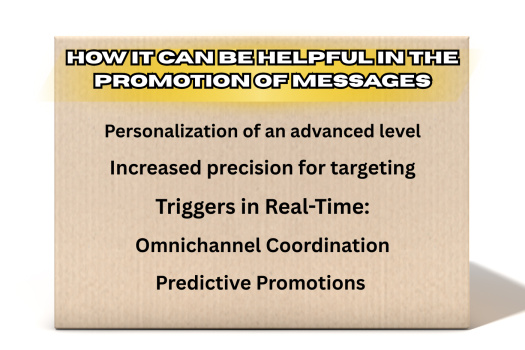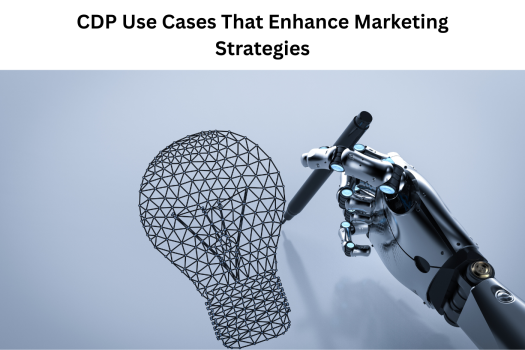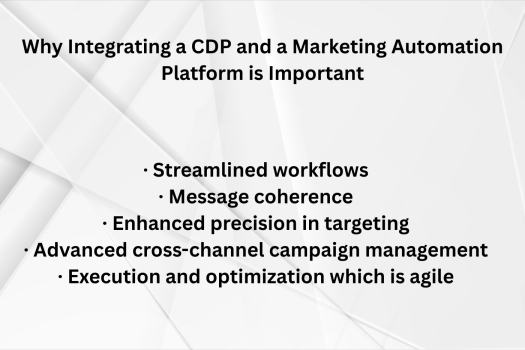BLOG'S
Table of Contents
Published on: May 16, 2025 04:42 PM
CDP and Marketing Automation: How Do They Differ?
The modern digital marketplace is
fast-paced and unrelenting. Businesses, now more than ever, strive to
appreciate their customers better and improve their marketing tactics. Two
cardinal tools that enable this include; CDPs
and Marketing Automation platforms.
It is a common misconception that these tools are one in the same. Regardless
of the confusion, both serve different, yet important roles in the marketing
technology stack. When utilized together, businesses stand a chance of
achieving efficient personalized marketing
campaigns, streamlined customer
lifecycle automation and enhanced cross-channel campaign management.
Exploring the differences between
a Customer Data Platform and a Marketing Automation Platform, their
respective data collection methods, method of leveraging them for data
promotion, the advantages and disadvantages, as well as important CDP use cases will be the focal point
of this article.
What is a Customer Data Platform (CDP)?
Let us dive deeper into the first
question, What is Customer data
platform?
By definition, a Customer Data Platform (CDP) is a system that integrates data
from various sources to create a profile with a 360 degree view of the
customer. These profiles are then shared with other systems in order to enable
tailored marketing and context relevant engagements.
The best customer data platform derives and consolidates information
from a customer’s online activities, mobile applications, emails, CRM systems,
social media accounts and even offline channels such as in-store visits. It
aids in unifying first-party data
marketing by offering a singular truth repository for every customer.
Key Functions of a CDP:
·
A Unified Multi-Source Data Collection System.
·
Identity resolution.
·
Real-time customer
segmentation tools.
·
Downstream Tool Integration (CDP integration)
·
Privacy and compliance support.
A CDP in summary, a CDP is the
primary infrastructure for customer insights while providing advanced
data-driven marketing operations and personalization.
What is a Marketing Automation Platform?

A Marketing Automation Platform
is software that automates the execution of low-level repetitive promotional
tasks and sends tailored content to groups of users. This type of platform
assists marketers in the planning, execution, and evaluation of defined workflows
(including e-mail, SMS and push notification campaigns).
Marketing automation tools enable the streamlined execution of
onboarding processes, respond to prospective clients and facilitate interactions
with existing clients. He/They support sophisticated automated customer journey maps and provide
distant relevancy behavioral triggers.
Key Features of Marketing Automation Platforms Include:
·
Automated Emails and SMS Messages
·
Messaging Based on Customer Actions
·
Lead Scoring and Nurturing
·
Analytics for Campaigns and Ongoing Improvements
·
AI technologies in Marketing Automation for Predictive Analytics
When brands implement Technologies
of AI in marketing, they are able to
tailor customer journeys in the moment, resulting in higher revenue-generating
actions.
CDP vs Marketing Automation: The Most Important Aspects
The difference in a Customer Data Platform and a Marketing Automation Platform is in
their primary focus. A CDP is concerned about gathering, organizing and
centralizing all customer data, while the marketing automation platforms
concentrate on using the data to run campaigns.
|
Feature |
Customer Data Platform (CDP) |
Marketing Automation Platform |
|
Function |
Data unification and analysis |
Campaign automation and execution |
|
Data Type |
Behavioral, transactional,
demographic |
Engagement, lead activity |
|
Use Case |
Profile building, CDP analytics |
Campaign delivery, nurturing |
|
AI Integration |
Used for predictive analytics and
segmentation |
Used for real-time personalization
(AI in marketing automation) |
|
Output |
Segments and unified profiles |
Emails, SMS, push notifications,
etc. |
Together, both platforms improve
targeting accuracy and implement effective strategies of CDP with marketing
automation.
How customer data is gathered by marketing and automation platforms?
Both categories are centered on
data, but each approaches it differently.
Methods of Collecting CDP Data
A CDP collects data from these
below specified areas:
·
Website and mobile app usage
·
The CRM, along with the associated transactional
databases
·
Email management systems
·
Offline sources like telephone call centers,
retail outlets
As a result, this enables
crafting in-depth and live profiles that bolster first party data marketing initiatives. In turn,
this data enables marketers to execute extreme targeting through personalized marketing campaigns.
Data Collection from Marketing Automation
The following data points are
captured by marketing automation tools:
·
Clicks and opens
·
Page visits and submission of associated forms
·
Engagement during campaigns
The data captured in automation
supports lifecycle automation of a customer, helping you to shape strategic
messages suitable for every step of the customer's journey.
How It Can Be Helpful In The Promotion Of Messages?

The combination of CDPs and
marketing automation is quite beneficial for the promotion of messages. Here is
how:
1. Personalization of an advanced level
Unified profiles allowed through
the CDP provides a marketer with the ability to create tailored advertising
strategies that take into account the customer's preferences, habits, and
previous purchases.
2. Increased precision for targeting
Through the customer segmentation tools, marketers are able to identify
top-tier audiences for particular promotions and automatically matching these
segments to the automation platform.
3. Triggers in Real-Time
Insights on customers issued
through CDPs are current and can in turn lead to instant messaging actions done
through an automation system like sending customized messages for offers when
users leave items in their shopping carts.
4. Omnichannel Coordination
The integration facilitates omnichannel marketing automation,
integrating email, SMS, push and even social media channels
for messaging coherence.
5. Predictive Promotions
With CDP analytics and marketing
automation with AI, brands can predict high-performing messages and
customize the tone, timing and channel.
Basically, this integration
enables marketers to build highly…flexible and powerful promotional campaigns
fueled by deep customer insights.
Advantages and Disadvantages of CDPs and Marketing Automation Tools
Pros of Customer Data Platforms:
·
Brings together disparate data sources.
·
Improves targeting through enhanced personalization
and positioning.
·
Aids in adhering to laws concerning data
privacy.
·
Strengthens CDP
for eCommerce through forward-looking insights.
·
Facilitates advanced CDP analytics and segmentation.
Cons of Customer Data Platforms:
·
Integration and infrastructure spend is
required.
·
Can be difficult for smaller firms.
·
Focus is not on executing campaigns.
Pros of Marketing Automation Platforms:
·
Takes care of tedious work.
·
Improves uniformity in executing campaigns.
·
Assists in managing campaigns across multiple channels.
·
Powers engagement and lead nurturing.
Cons of Marketing Automation Platforms:
·
Lacks the ability to collect data without a CDP.
·
If not paired with intelligent insights may lead
to one-size-fits-all messaging.
·
Without integrated data, effective segmentation
is more challenging.
CDP vs CRM vs Marketing Automation
Mixed up are CDP vs CRM vs
Marketing Automation. Here is a short explanation.
CRM: Keeps contact information and manages relationships with
clients for the sales teams.
CDP: Collects and integrates all customer data through different
touchpoints to enable deeper marketing analysis.
Marketing Automation: Executes targeted campaigns across multiple
channels based on the insights gained from them.
As a CRM tells you who your customers
are, a CDP tells you what activities they do. As for marketing automation, it
tells you how to reach them effectively.
CDP Use Cases That Enhance Marketing Strategies

1. Abandoned
Cart Recovery
·
CDP for
eCommerce identifies clients who walked away without finalizing payment.
·
The segment is synced with a marketing
automation tool.
·
Customer journeys are automated with
personalized messages containing rewards throughout.
2. Welcome
Campaigns
·
Welcome email or message is sent after new
clients are registered through the CDP.
·
Customer data, as well as interaction data, are
recorded in the CDP.
·
A customer segmentation tool groups users by
their source as well as demographics and interests.
·
A tailored welcome sequence is initiated through
marketing automation.
3. Re-Engagement
Campaigns
·
Inactive users are detected with CDP analytics.
·
The users are personally addressed with tailored
win-back emails during the inactivity phase.
·
Content and offers are tailored based on user
interaction history with the brand.
4. Product
Recommendations
·
Purchase history and browsing data are tracked
by the CDP.
·
Related products are recognized by machine
learning systems.
·
AI-driven
marketing automation offers suggestions through emails and on-site
messages.
5. Loyalty
Program Promotion
·
Business Value Program members are identified.
·
Promotion through email, SMS and App
notifications are done as omni-channel marketing automation guarantees interval
consistency.
·
Customer Lifecycle automation grants dynamic
rewards that change based on the stage in the customer lifecycle.
Why Integrating a CDP and a Marketing Automation Platform is Important?

The integration of the two platforms
still further means:
·
Streamlined workflows
·
Message coherence
·
Enhanced precision in targeting
·
Advanced cross-channel campaign management
·
Execution and optimization which is agile
With effective CDP integration, marketing departments
can understand and visualize the entire customer journey and, at the same time,
engage the audience with appropriately timed messages throughout the customer
lifecycle.
Conclusion
In simple words, knowing the
difference between Customer Data
Platform and Marketing Automation
Platform is vital in executing data-driven marketing campaigns. The
intelligence is provided by CDPs – collecting and organizing data – while
action is executed by the marketing
automation tools.
The future of customer engagement
lies in combining these two systems to execute automated customer journeys, hyper-precision targeted personal marketing campaigns and instantaneous,
real-time decisions fueled by AI in
marketing automation.
For scalable and customer focused
marketing strategies, it is best first to select the customer data platform that fits the business needs, ensuring
seamless CDP integration and
optimizing the marketing automation
tools in use.